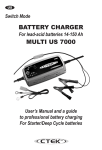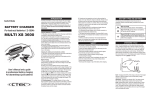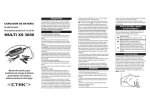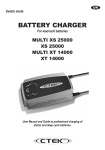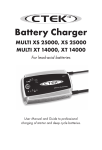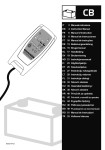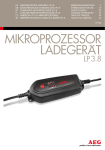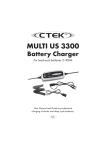Download CTEK Multi XS 7000 User`s manual
Transcript
UK Switch Mode BATTERY CHARGER For lead-acid batteries 14-225Ah MULTI XS 7000 INTRODUCTION Congratulations to your new professional MULTI XS 7000 Switch Mode Charger with Pulse Maintenance, Boost and Float. MULTI XS 7000 is a member of a family of professional chargers from CTEK Sweden AB. It represents the state-of-the-art of today’s technology for battery charging. A MULTI XS 7000 will prolong the lifetime of your battery. Please read this manual carefully and follow the instructions. SAFETY • The charger is designed for lead-acid batteries 14-225 Ah. Do not use for any other purposes. • Always use safety glasses and turn your face away from the battery when making or breaking connections! • A battery being charged could emit explosive gasses. Prevent flames and sparks close to the battery. • Always provide for proper ventilation during charging. • Avoid covering the charger. • Battery acid is corrosive. Rinse immediately with water if acid comes into contact with skin or eyes. Seek medical advice. • Don’t charge a frozen battery. • Never operate a damaged charger. • Never place the charger on top of the battery when charging. • Always check that the charger has gone over to maintenance charging mode before leaving the charger unattended and connected for long periods. If the charger had not gone over to maintenance charging with 72 hours, this is an indication of an error. In this case the charger must be disconnected manually. • All batteries fail sooner or later. A battery that fails during charging is normally taken care of by the chargers advanced control, but some rare errors in the battery could still exist. Don’t leave any. battery unattended for a longer period of time. BATTERY TYPES AND SETTINGS MULTI XS 7000 can easily be set for different types of batteries or conditions. The following recommendations should, however, only be seen as guidelines. Please consult the battery manufacturer for further instructions. Settings are made by pressing the ”MODE-button” and stepping forward one press at a time until the required mode is reached, the button is then released. After about 2 seconds the charger activates the selected mode. The selected mode is saved in a memory in the charger and remains there even if the charger is switched off. User’s Manual and a guide to professional battery charging. For Starter/Deep Cycle batteries. Mode 14.4 V - Normal setting for wet batteries, MF and for most Gel batteries. Mode 14.7 V - This setting is recommended for a battery at temperatures < 5 degrees C. It is also recommended for many AGM batteries like Optima, Maxxima and Odysseys. Consult your battery manufacturer when in doubt. Mode 13.6 V / Supply - The charger is operating at a constant voltage of 13.6 V. This is the maintenance mode for applications where maximum capacity from the battery is important, like floor sweepers and golf carts. The MULTI XS 7000 could also be used as a power supply without a battery attached in this setting. Note that the Spark Free function is suppressed in this mode. Mode 16 V / 1.5 A / 4 h - This mode is used to recover deep discharged batteries where you could expect a stratified acid (high acid weight in the bottom, low on top). Note that the battery has to be fully charged first. Use this mode with care, because the high voltage will cause some water loss. 16 V is normally no problem for electronics, but consult your supplier when in doubt. Life of light bulbs will reduced at higher voltage. Try to avoid using 12 V light from the battery during this phase. Maximum effect and minimum risk for electronics is achieved by charging a disconnected battery. CHARGING Charging batteries in a vehicle: 1. The power cord should be disconnected before connection or disconnection of the battery leads. 2. Identify the pole that is grounded. Ground is normally connected to the negative terminal. 3. Charging of negative grounded battery: Connect the red wire to the positive pole of the battery and the black cable to ground. Be aware that the connection isn’t made to a metal fuel pipe. 4. Charging of positive grounded battery: Connect the black wire to the negative pole of the battery and the red cable to ground. Be aware that the connection isn't made to a metal fuel pipe. Charging of a battery not connected to a vehicle: 1. The power cord should be disconnected before connection or disconnection of the battery leads. 2. Connect the red wire to the positive pole of the battery and the black cable to the negative pole. The red alarm indication light (0) will indicate a battery, which is connected to reverse polarity (will not work in Supply Mode). The red alarm indication light (0) will also indicate if the charge cycle is activated without any battery connected to the battery leads. Start charging 1. Connect the power cord to the power outlet. The charger indicates STANDBY, yellow indication light (A). 2. Set the proper charging mode for the battery by pushing the Mode Selector Button (see Battery Types and Settings). 3. The lamp for Deep Discharged battery (1) will indicate if the battery has been discharged down to below 10.5 V. A boost phase could be needed after the completed charge cycle. 4. Normal charging settings (14.4 V or 14.7 V) will be indicated by the lamps for Deep Discharged (1), Bulk Charge (2), Absorption Charge (3) or Maintenance Charge (4). The lamp for maintenance means that the battery is fully charged. The charge will restart if the voltage drops. The charger can by connected for months. The Supply or Boost settings are indicated by the lamps for those settings. 5.The red alarm indication light (0) will indicate a battery, which is connected to reverse polarity (will not work in Supply Mode). The red alarm indication light (0) will also indicate if the charge cycle is activated without any battery connected to the battery leads. 6. If nothing happens: A bad connection of the battery to ground will be indicated by a no light from the charging lamps or that the indicator lamp is still in the Standby-mode (lamp A). A bad battery will also be indicated in the same way. Don’t forget to check the wall outlet. If you experience problems: start with the sensitive connection between the battery clamps and the charger. 7. A flickering between the lamps for charging and fully charged could be caused by several reasons. a. A lost connection. This is most likely in the cabling but could also be internal. Put the charger in STANDBY and try to restart. b. A lightly sulphated battery which has problems to be initiated. The flickering will end within 60 minutes if the battery could be recovered. The battery cannot be recharged if the flickering continues. c. A battery with high self discharge could be seen when the Fully charged lamp is on for 10 seconds and more, combined with a short Charge indication. Such a battery is at the end of its life and needs to be replaced. 8. The charging could be interrupted at any time by disconnecting the supply cord or by setting the charger in Stand by. Removing the ground lead first when disconnecting the battery leads from a battery in a vehicle. MULTI XS 7000 performs a 5-step fully automatic charge cycle, IIUoIUp. Lamp B for 14.4 V or Lamp C for 14.7 V. Start: Starting phase for charging. The current is restricted to 3 A. It ends when the voltage is above 10.5 V. There is a time-out after 6 hours and the charger switches to Error indication, (lamp 0). This indicates a faulty battery or an undersized charger for the battery pack. Lamp 1 indicates this phase. Bulk: Main part of the charge cycle when about 80% of the charge is returned. The charge is carried out at maximum charge until full voltage is achieved. Lamp 2 indicates this phase. Absorption: Final part of the charge. The voltage is kept constant until the current has dropped to a very low level. The phase is also ended if the total time for bulk and absorption exceeds 40 hours. Lamp 3 indicates this phase. Pulse Maintenance charge: The state of charge is between 95% and 100%. A pulse at 5 A is sent out if the voltage drops. This gives minimum water loss and maximum life. The charger could be connected for years without problems. The charger measures the voltage every 10 minutes to decide whether a new pulse should come. This means that these pulses can’t come more often than every 10 minutes. If the battery is charged and/or the battery's terminal voltage drops below 12.7 V (Mode 14.4 V) or 12.9 V (Mode 14.7 V), the charger starts a charge pulse of 5A until the terminal voltage has reached the set level, 14.4 V or 14.7 V. The charge pulse is then interrupted and the cycle is repeated as long as the charger is in pulse maintenance phase. Pulse maintenance phase is indicated by lamp 4. If the terminal voltage drops below 12.1 V, the charger automatically reverts to the beginning of the charging curve. Setting : Supply 13.6 V MULTI XS 7000 has a Supply mode setting which has a constant voltage at 13.6 V and current up to 7 A. It could be used for maintenance charge using the Float approach. This approach keeps the battery at 100 % State of Charge, but the constant small overcharge also increases water loss. Note that there is no need for a battery to be connected at this mode. Note that the Spark Free function and the indication of Reverse Polarity is suppressed in this mode. The protection is still working. It is not advisable to charge a discharged battery in Supply mode as this will not provide a complete charge. In this mode, MULTI XS 7000 can also be used as a power-generation unit for operating equipment that requires 13.6 V and a maximum of 7 A. If the selected current exceeds 7 A, the output voltage will drop at an increasing rate. The charger has electronic overload protection in this mode, which is activated if the charge is so great that the output voltage from the charger falls below around 3.5 V and the current to around 7 A. In the event of an overload, the charger transfers to error mode (lamp 0). Setting lamp D indication lamp 5. Setting: Boost 16 V / 1.5 A / 4 h MULTI XS 7000 has a Boost-setting which gives a constant current at 1.5 A, maximised at 16 V for 4 hours. It will automatically go over to 14.4 V pulse setting after a completed cycle. This mode is used for batteries that have been deep discharged. Start by charging at either the 14.4 V or 14.7 V setting until the battery is in Pulse maintenance phase. Setting lamp E indication lamp 6. SPECIFICATION BULK CHARGING TIME Voltage AC Battery size (Ah) Time to ~80% charge (h) 20 3 75 10 115 16 225 32 TEMPERATURE PROTECTION The charger is internally protected from being overheated. The power will be reduced if the ambient temperature is increased. MAINTENANCE A MULTI XS 7000 doesn’t need any specific maintenance. Observe that disassembly of the charger is not allowed and will void the warranty. A defective power cord has to be replaced. Keep your charger clean. It could be wiped of with a soft tissue, after disconnecting the power supply. EQUIPMENT MULTI XS 7000 is delivered with a set of battery leads with battery pole clamps. LIMITED WARRANTY CTEK SWEDEN AB, Rostugnsv. 3, SE-776 70 VIKMANSHYTTAN, SWEDEN makes this limited warranty to the original purchaser of this product. This limited warranty is not transferable. CTEK SWEDEN AB warrants this unit for two years from date of purchase against defect workmanship or material. It is the obligation of the purchaser to forward the unit together with proof of purchase to the manufacturer or its representative with transportation cost prepaid. This warranty is void if the unit is abused, handled carelessly or repaired by anyone other than CTEK SWEDEN AB or its authorized representative. CTEK SWEDEN AB makes no warranty other than this limited warranty and expressly excludes any implied warranty including any warranty for consequential damages. This is the only expressed limited warranty and CTEK SWEDEN AB neither assumes nor authorizes anyone to assume or make any other obligation towards the product other than his limited warranty. Current Inrush Current Back Current Drain* Charging Voltage Ripple** Charging Current Ambient Temperature Cooling Charge cycle Type of batteries Battery Capacity Dimensions Insulation Weight INDICATIONS 220-240 VAC, 50-60 Hz. Output power is reduced at lower input voltage. A perfect charge will still be achieved. 0.9 A rms < 40 A < 3 mA Nominal: 12 V 13.6 V, 14.4 V, 14.7 V or 16 V Max 150 mV rms, max 0.3 A 7 A max - 20°C till + 50°C. Automatic reduction of power at increased ambient temperature. Natural convention 5 step fully automatic IIUoIUp. All types of lead-acid batteries (Wet, MF, VRLA, AGM and GEL) 14-225 Ah 191 x 89 x 48 mm (L x W x H) IP 65 0.8 kg *) Back Current Drain is what drains the battery if the charger is connected without the power cord connected. **) Quality of the current and voltage is very important. High current ripple heats up the battery and makes the positive electrode age prematurely. High voltage ripple could harm other equipment connected to the battery. MULTI XS 7000 produces a high quality current and voltage with very low ripple. Manufacturer: CTEK SWEDEN AB, Rostugnsvägen 3, SE-776 70 VIKMANSHYTTAN, SWEDEN, Declares under sole responsibility that the battery charger MULTI XS 7000, to which this declaration relates is in conformity with the following standards: EN60335-1, EN 60335-2-29 following the provisions of directive 73/23/EEC amended by 93/68/EEC and EN 55014-1, EN 61000-3-3, EN 610002/03/00, EN 55014-2 following the provisions of directive 89/336/EEC amended by 92/31/EEC and 93/68/EEC. VIKMANSHYTTAN, SWEDEN, 10/10/02 Börje Maleus, Managing Director, CTEK SWEDEN AB CTEK SWEDEN AB, Rostugnsvägen 3 SE-776 70 VIKMANSHYTTAN SWEDEN Fax: +46 225 30793 www.ctek.se 3 2 0 4 5 1 6 A Indication 0 1 2 3 4 5 6 DECLARATION OF CONFORMITY B C D E Description Error mode, the charger interrupts the charging/voltage supply. See description below. Start mode, restricted charging current and battery voltage under 10.5 V. Bulk charging, Maximum charging current. Absorption charging, Voltage restrictions to selected voltage. Pulse maintenance charging. Supply mode, fixed output voltage, no counter voltage requirements. Boost charging in progress, constant current 1.5 A. Error mode The charger goes to error mode in the following situations: 1. Charging is started without a battery with terminal voltage over 1.5 V being connected to the terminals. 2. The battery is connected with poles reversed to the charger's terminals. 3. The terminals on the charger are short-circuited when charging has started. 4. The charger is overloaded in Supply mode. 5. The charger has been in start mode for more than 6 hours. 6. If the total time for bulk and absorption exceeds 40 hours. Error mode is acknowledged/reset by pressing ”the MODE” button. The charger restarts in the latest selected mode. 002 CHARGING CYCLE Setting: 14.4 V or 14.7 V


